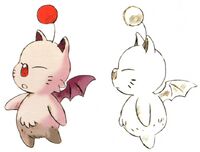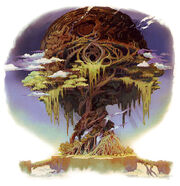Template:Sideicon
Template:Infobox CVG Final Fantasy IX is the ninth installment in the Final Fantasy series, released by Square in 2000. It is directed by Hiroyuki Ito and co-produced by Hironobu Sakaguchi and Shinji Hashimoto. It is the third and last Final Fantasy in the main series to be produced for the PlayStation. Unlike Final Fantasy VII and Final Fantasy VIII, Final Fantasy IX was not immediately ported to the PC. A Steam version was released on the 14th of April 2016. On April 2nd, 2010, it was announced on Twitter that Final Fantasy IX would be added to the PlayStation Network, and was released for PSN on May 20th, 2010 for Japanese players, May 26th, 2010 for European and Australian players, and on June 15, 2010 for North American players.
After two Final Fantasy installments that featured an increasing sci-fi slant, Final Fantasy IX was intended to return the series, at least temporarily, to its more fantasy-oriented roots. The characters, who had been depicted in an increasingly realistic fashion in previous Final Fantasy games, were deliberately rendered more cartoonish. Among the most notable Final Fantasy traditions is the presence of black mages, represented foremost by the playable party member Vivi.
Final Fantasy IX was announced and developed in tandem with Final Fantasy X and Final Fantasy XI. This three-pronged marketing effort was intended to provide gamers with the promise of three upcoming games of varied style and gameplay: an intentionally retro RPG in Final Fantasy IX, a smoother evolution in style and design in Final Fantasy X, and an online experience in Final Fantasy XI.
On December 31, 2015 Square Enix announced the game will be ported to iOS, Microsoft Windows via Steam, and Android.[1]
Gameplay
In the field, the player typically controls the main character, Zidane. When he passes a point of interest, a ! or ? bubble appears above his head, and the player can press ![]() to interact with the object. As the game progresses, different methods of traveling across the world become available, such as chocobo, boat and airship.
to interact with the object. As the game progresses, different methods of traveling across the world become available, such as chocobo, boat and airship.
Levels and abilities
Party members level up by accumulating experience points from regular enemies; bosses yield no EXP. New abilities are learned by equipping an item that can teach it and gaining ability points to learn it permanently, reminiscent of the esper system in Final Fantasy VI. However, in Final Fantasy IX abilities can be used even before they have been learned.
Abilities can be learned faster by equipping multiple pieces of equipment that teach the same ability; e.g. Zidane will learn Long Reach twice as fast if he equips both Thief Hat and Protect Ring simultaneously. The effect is boosted further by using the Ability Up ability.
There are two types of abilities: "Action" and "Support". Action abilities include techniques like magic, weapon skills and calling eidolons. Support abilities have beneficial passive effects, such as resistance against status effects and increased damage to certain enemy types.
A limited amount of support abilities can be equipped at one time, governed by Magic Stones. Each support ability requires a certain number of Magic Stones, and more stones can be gained by leveling up. Many abilities can be learned by most of the cast, but some are exclusive.
Battles
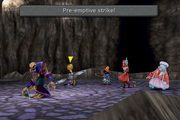
A battle in Final Fantasy IX.
Following the tradition started by Final Fantasy IV, the game utilizes the Active Time Battle system. When a character's ATB gauge is filled, they can choose a command to execute. Normally, enemies attack whenever their turn is up, but the battle can be set to "Wait" mode, making the enemy unable to perform while players are choosing a spell or an item from the menu.
In Final Fantasy VII and Final Fantasy VIII, the player was restricted to three-person parties. In Final Fantasy IX, this is changed to the classic four-person party. The game allows for two players to control members chosen by the player in the battle.
Zidane is in the player's party most of the time. His Steal skill is very useful, since many pieces of equipment are available first as steals from bosses before being purchasable from vendors.
Trance
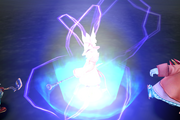
Steiner enters Trance.
Continuing the tradition started in Final Fantasy VII, the game incorporates Limit Breaks, although differently from earlier Limit Break systems. When a character sustains hits in battle, the Trance gauge is filled and when full, the character enters Trance. Trance changes the character's appearance, and gives them a new skill or set of skills only usable while they are in Trance.
For example, if Zidane has learned the ability Flee for his Skills ability set, he gains the ability Free Energy for his Trance ability set, Dyne. Zidane is the only character to use new abilities in his Trance; most characters' abilities are enhanced, for example, Vivi gains Double Black, which allows him to cast two Blk Mag spells in succession, and while in Trance, Steiner's strength is boosted.
Character classes
While not explicitly stated, each party member has a job based on previous Final Fantasy games. For example, Zidane is a Thief, Amarant is a cross between a Ninja and a Monk, and Quina is a Blue Mage.
This is yet another return to tradition from the recent predecessors of Final Fantasy IX, in which characters were largely blank slates to be heavily customized by the player. In Final Fantasy IX the emphasis is on building an effective team of characters whose strengths and weaknesses balance one another.
Active Time Events
Another new aspect of Final Fantasy IX are Active Time Events (ATE). When an ATE window appears the player can press ![]() to see what the other characters are doing. Although watching an ATE might not always affect the main storyline, sometimes, when the notification text appears gray, the player will have to watch an ATE automatically. The player might gain items or gil by watching the ATEs. Sometimes, multiple choices for ATEs are given, and if one is picked, the other might not be able to be activated, meaning the player has to wait for a second playthrough to see it.
to see what the other characters are doing. Although watching an ATE might not always affect the main storyline, sometimes, when the notification text appears gray, the player will have to watch an ATE automatically. The player might gain items or gil by watching the ATEs. Sometimes, multiple choices for ATEs are given, and if one is picked, the other might not be able to be activated, meaning the player has to wait for a second playthrough to see it.
Mognet
Within the game, Mognet is a postal system operated by moogles. As the player progresses they will find moogles inhabiting most of the known world. When the player talks to a moogle, they allow the player to save their game, restore life energy via Tents, or purchase items with Mogshop.
The moogle may also request that the player character act as a courier by delivering a letter to another moogle. It is also possible (albeit less frequently) that the player receives a letter from someone else.
Later on it is revealed the moogles are requesting the player to deliver letters because Mognet Central, where the letters are usually sorted, is having mechanical problems, and as a result, deliveries have become sporadic. The player may help the moogles restore Mognet Central's functionality in a sidequest.
Minigames and sidequests
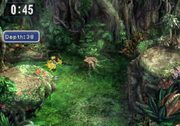
A game of Chocobo Hot and Cold.
Final Fantasy IX has two main side quests that span a lot of the game: the Tetra Master card game that can be played with almost any NPC, and Chocobo Hot and Cold. The player can obtain their first Tetra Master deck and tutorial on how to play at the start of the game, and then keep challenging NPCs for games. New cards are also obtained as drops from enemies. The player must go out of their way to obtain the rarest cards in the game if they want to complete their deck.
Chocobo Hot and Cold can be played once the player meets up with Choco in Chocobo's Forest. There are different venues where the player can play the minigame to have Choco dig up random treasures and chocographs that can be used to dig up treasures on the world map. By discovering more chocographs the player can level up their chocobo to reach new areas with ever better treasures. Many of the game's ultimate equipment can only be obtained from these treasures.
Other minigames include frog catching where Quina must catch frogs on Qu's Marshes for rewards, the jump rope game Vivi and Eiko can play in Alexandria and the footrace game against Hippaul. The game has numerous sidequests from collecting rare key items, to encountering the friendly enemies and Ragtime Mouse on the field in random battles. Notoriously, the game had a sidequest that remained largely unknown and unnoted in guides for years until being discovered from the game's Ultimania guide, the Nero family sidequest in Lindblum.
Synopsis
Setting
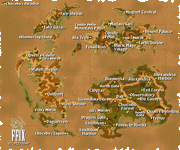
Final Fantasy IX world map.
The world of Gaia is divided into four continents, the most populated one being the Mist Continent. Most of the sentient races have settled above the Mist that covers the bottom of the continent. Mist, its origins unknown, is a noxious gas that mutates flora and fauna alike into monsters, and hardens the hearts of men inciting strife among them. As sunlight penetrates the Mist poorly, the surface of the continent is left in perpetual shadow where monsters lurk. Thus, most people elect to live on the plateaus above the Mist and cross the lands in Mist-powered airships rather than on foot.
There are four major kingdoms on the continent: Alexandria, reigned by Queen Brahne Raza Alexandros XVI; the industrious Lindblum, governed by Regent Cid Fabool IX; the nation of the Dragon Knights Burmecia, reigned by the King of Burmecia; and the mysterious Cleyra hidden inside a perpetual sandstorm. Lindblum is the most technologically advanced nation of the four, and the inventor of Mist-powered airships that halted the wars that had plagued the continent for centuries.
Though shrouded in Mist and thus full of ferocious monsters, Mist Continent is the most lush continent on Gaia, the others being barren. The other continents are rarely traveled to, as they are free of Mist and thus out of the reach of airships. Outer Continent is an arid wasteland to the north, connected to the Mist Continent by the Fossil Roo, but only the dwarves are known to live there. Lost Continent, to the northwest, is almost entirely covered in ice, but houses the volcanic Mount Gulug and the religious center of Esto Gaza that reveres the legends of a Shimmering Island off the coast of the continent. The Forgotten Continent is a a large land in the west where the sun sets, with mysterious ruins scattering its landscape.
Characters
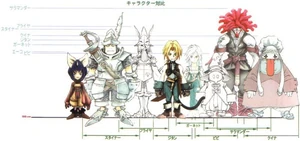
The playable characters of Final Fantasy IX.
- Zidane Tribal: The main protagonist. A Thief, member of the Tantalus group, and an inveterate womanizer.
- Vivi Ornitier: A young black mage, but is pure of heart.
- Garnet Til Alexandros XVII: The female protagonist, and princess of Alexandria. A summoner with more emphasis on summons than White Magic.
- Adelbert Steiner: A noble knight of Alexandria, and the Captain of the Knights of Pluto.
- Freya Crescent: A Burmecian Dragon Knight who searches for her lost love, Sir Fratley.
- Quina Quen: A qu Blue Mage who joins the adventure to experience cuisine from around the world.
- Eiko Carol: A young Summoner with more proficiency in White Magic than summoning, one of the last of her tribe.
- Amarant Coral: A Monk and wanted bandit, accompanying Zidane to discover what makes him powerful.
Story
Kidnapping the princess
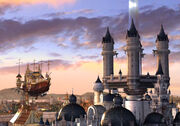
The Prima Vista approaches Alexandria.
Queen Brahne Raza Alexandros XVI of the kingdom of Alexandria lusts for power, and seeks to increase her domain by conquering the surrounding lands. Regent Cid of Lindblum worries how this will impact Princess Garnet, and dispatches the Tantalus Theater Troupe to kidnap her.
The princess yearns to escape from her wicked mother and willingly boards the Theater Ship. During the operation Vivi, a lone black mage, and Adelbert Steiner, Captain of the Royal Knights of Pluto, become involved, and during their escape the Theater Ship is shot down and crashes into the Evil Forest. Brahne is outraged Garnet escaped with a valuable crystal, a royal heirloom, and dispatches the Black Waltzes to retrieve her.
Zidane wants to find the missing princess, but Baku, the leader of Tantalus, dissents and dismisses Zidane from Tantalus. Vivi and Steiner join Zidane in rescuing Garnet from the forest's carnivorous flora and escape the woods, leaving Tantalus behind. The escapade rouses the forest made sentient by the Mist that petrifies itself. A Tantalus member, Blank, wishes to aid Zidane, but when delivering him a map of the rarely-traversed surface of the Mist Continent, gets caught by the forest vines and petrified along with the woods.
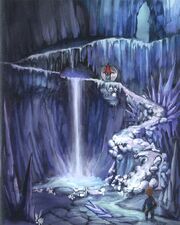
Artwork of Black Waltz in the Ice Cavern.
Zidane, Garnet, Vivi and Steiner pass through the Ice Cavern to get above the Mist, and Zidane defeats Black Waltz 1, Brahne's lackey sent to retrieve Garnet's royal pendant. Before arriving in the village of Dali, Garnet adopts the alias of "Dagger" to blend in with the peasantry. The villagers kidnap Vivi and the party is shocked when they rescue him and discover the villagers are manufacturing black mages, automaton dolls, from the Mist for export to Alexandria.
Garnet ponders returning to Alexandria to confront her mother about the black mage business, a notion Steiner approves of. After besting Black Waltz 2 they board a cargo ship piloted by automaton black mages. They come under fire from Black Waltz 3 and Vivi, Zidane, and Steiner confront the golem leaving the journey's destination in Garnet's hands. The princess hesitates, but ultimately decides to head for Lindblum, resulting in an erratic flight through the South Gate crashing the Black Waltz's airship.
Kuja
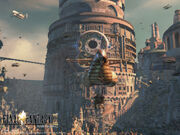
The party arrives in Lindblum.
The four meet with Regent Cid in Lindblum, and are surprised to find he has been turned into an oglop, an insect most find disgusting, by a magic spell from his absconded wife, Hildagarde Fabool. Cid refuses to mobilize against Alexandria for fear of leaving his borders unprotected. While Lindblum hosts the Festival of the Hunt Brahne advances into Burmecia, home of Zidane's friend Freya Crescent who aids him during the festival. Zidane wants to accompany Freya to Burmecia and Vivi wishes to come along to learn more about the black mages; he has no memory of his past beyond being cared for by his late "grandpa" Quan, and fears he may not be human.
Cid orders Garnet to remain in Lindblum. In retaliation, she tampers the festival feast with sleeping weed and absconds with Steiner back to South Gate. The others venture to Burmecia, recruiting the gluttonous Quina Quen along the way. They find Burmecia abandoned and decimated by Brahne's black mage army. At the city apex they meet the queen along with General Beatrix and a mysterious man named Kuja. Beatrix defeats Zidane's group, and Brahne sets her sights on Cleyra.
Meanwhile, Garnet and Steiner run into Marcus from Tantalus, who wants to save his friend Blank from the Evil Forest, but needs an item known as Supersoft to heal his petrification. Garnet feels culpable for Blank's fate and agrees to help in Marcus's quest much to Steiner's dismay. The three are attacked by the malfunctioning Black Waltz 3 and destroy him for good, before making their way to the city of Treno where they sneak into the basement of a noble's mansion. The noble turns out to be Garnet's old tutor, Doctor Tot, who relinquishes the Supersoft willingly and advices the three to take the Gargan Roo pathway to Alexandria where Garnet meets with her mother and Marcus and Steiner are imprisoned.

Odin's destructive dash towards Cleyra.
Zidane, Freya, Vivi and Quina head for Cleyra where the Burmecians are said to have evacuated. They make their way into the city and warn of the impending attack, and the Cleyrans perform a ritual to strengthen the sandstorm that protects the village. Something goes wrong and the sandstorm dissipates. Brahne has turned on the princess and ordered Garnet's eidolons extracted; magical creatures of legend. The queen's court jesters, Zorn and Thorn, extracted Garnet's eidolons into summoning gems and Brahne uses the eidolon Odin to obliterate Cleyra after Beatrix steals the nation's jewel. Zidane's crew hitches a ride on the Alexandrian airship Red Rose back to Alexandria Castle, leaving Quina behind.
Steiner and Marcus have broken free from imprisonment with Marcus departing for the Evil Forest to save Blank. Zidane's party joins forces with Steiner and they free Garnet from Brahne's clutches with the assistance of the enlightened Beatrix. While Steiner, Beatrix and Freya stay behind to secure their escape, Zidane, Vivi, and Garnet attempt to use the Gargant system to flee back to Treno. Their ride is spooked by a monster and they crash in Pinnacle Rocks where they meet the eidolon Ramuh. Having again lost Garnet, who still holds the royal pendant, Brahne hires two bounty hunters—Lani and Amarant—to capture her and kill Vivi, whom Brahne considers a rogue black mage.
Garnet is ambivalent on the power of eidolons that had remained latent within her without her knowledge, and that have now been stolen to be used by Brahne. After passing Ramuh's trial, giving Garnet the power to summon him, the three witness the invasion of Lindblum by a black mage army and another eidolon, Atomos. Sneaking into the surrendered city, Zidane and Garnet meet with the now powerless Regent Cid who reveals Kuja is the one supplying Brahne with the black mages. It is rumored the origin of Mist, the main ingredient in black mage production, lies in the Outer Continent, and the party sets off to locate Kuja there.
Revelations
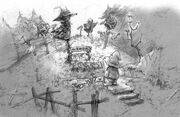
Vivi at the black mages' graveyard.
They run into Quina at Qu's Marsh who had escaped Cleyra and returned to his/her home. Quina helps the party locate the entrance to Fossil Roo, an ancient route said to lead to the Outer Continent, where the party is accosted by Lani on her quest to retrieve the princess, but they defeat her. On the Outer Continent the party finds the Black Mage Village where many sentient black mages like Vivi live, having defected the Alexandrian army and founded a settlement far away from conflict. Vivi discovers black mages have a lifespan of about one year, and many of the earliest builds of black mages have already started to "stop".
After passing through the dwarves' village of Conde Petie they meet Eiko Carol, a young girl and last of the summoner tribe, who leads the party to her home of Madain Sari. They find Madain Sari is a ruined village where Eiko lives alone with a group of moogles, and Garnet learns the truth of her past: she is a summoner born in Madain Sari, but in the aftermath of the village's destruction ten years ago, she had washed up in Alexandria where she had replaced the recently deceased Princess Garnet. Having lost her memories in the calamity, Garnet was raised believing Queen Brahne was her mother, never having learned she possessed eidolons.
Zidane convinces Eiko to open the path to the Iifa Tree, a colossal tree that towers over the landscape and is mysteriously shrouded in Mist despite the rest of the continent being free of it. The group descends down the trunk all the way to the core of Gaia where they encounter Soulcage, who reveals the Mist's true purpose; Mist is the by-product of the Iifa Tree's true function, stopping Gaian souls from returning to their crystal in the planet core. The discarded souls are released as Mist on the Mist Continent via the Iifa Tree's roots that cover the whole planet within its crust, and the malevolent substance is responsible for the monsters that roam the depths of the continent, and was the culprit for inciting war among the nations until Mist-powered airships were invented.
Upon Soulcage's defeat the Mist dissipates, and the heroes return to Madain Sari where they find the bounty hunter Lani and her brooding companion Amarant. Upon finding an identical crystal in Madain Sari to that of Garnet's royal pendant, Lani takes Eiko hostage. Amarant no longer tolerates her methods and turns against her, driving her away, and joins Zidane's party.
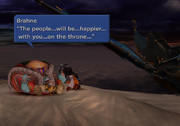
Brahne passes away.
They leave Quina in Madain Sari and return to the Iifa Tree and find Kuja. Queen Brahne and her navy appear off Iifa's coast to challenge him, as Brahne no longer considers him useful, having deemed the black mages disloyal for defecting, and already having attained the power of eidolons. Kuja summons his Silver Dragon and monsters of Mist to repel her, and Brahne retaliates by summoning Bahamut. Kuja calls the airship Invincible to enslave it. Now under Kuja's command, Bahamut wipes out Brahne and her soldiers with a devastating Mega Flare.
A dying Brahne washes up on the shore and with her final words apologizes to Garnet who must now become the queen of Alexandria. Alexandrian forces retreat from Lindblum and Garnet inherits the jewels her mother had stolen from the kingdoms she had conquered. Garnet shares the jewels with Eiko—each keeping two—to reinforce their bond as the last of the summoner tribe. Zidane is distraught he must part with Garnet for whom he had begun to have feelings for, and departs to Treno with the others to participate in the local Tetra Master tournament.
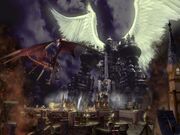
Alexander faces Bahamut.
The ceremonies of Garnet's coronation are short-lived as Kuja summons Bahamut to destroy Alexandria. The others fly in from Treno with Regent Cid's experimental airship, the Hilda Garde II, that can operate without Mist. Eiko and Garnet bring together the fragments of the ancient divided summoning gem, the true reason Brahne kept pursuing Garnet's royal pendant, and summon Alexander, the holy eidolon guardian of Alexandria. Alexander vanquishes Bahamut and Kuja, in awe of its power, calls for the Invincible to enslave it. A mysterious elderly man appears with the Invincible, reproaches Kuja for his rebellion, and destroys Alexander and a majority of the city. Kuja, left without an eidolon, flees.
Garnet is rendered mute by the trauma of seeing her kingdom decimated, and she, Zidane and their friends, now including Steiner and Freya, take refuge in Lindblum. Cid's mind is not what it used to be as an oglop, and thus his newest airship, the Hilda Garde II, is poorly designed. The party sets to find a cure for Cid but turns him into a frog instead. The party is reunited with Quina who has washed ashore in Lindblum, and Cid gives the party the ship Blue Narciss to track down Kuja, accompanying them on their quest.
They stop by the Black Mage Village and discover Kuja has tricked the black mages into following him by claiming he knows how to extend their lifespan. Now knowing where Kuja resides, the group infiltrates his Desert Palace but falls into a trap and becomes imprisoned. Kuja forces Zidane and three of his friends to fly to the Forgotten Continent and retrieve the Gulug Stone from Oeilvert in exchange for the life of their other friends. It turns out Kuja possesses Hilda Garde I, Cid's new airship model that can fly without Mist that Hilda took when she left him after having turned him into an oglop.

Artwork of the mysterious archive of Oeilvert.
Oeilvert turns out to be an ancient archive from a lost Terran civilization with many artifacts, including an ancient eidolon, Ark, which must be defeated to obtain the Gulug Stone. To Zidane's surprise, only he can decipher the language of Terra though he has never heard of this other world.
Meanwhile, Regent Cid and the remaining party members break free and shut down the palace security system, Valia Pira. Kuja snatches the Gulug Stone from Zidane and absconds with an abducted Eiko to Mount Gulug where Kuja wishes to obtain an eidolon stronger than Alexander to fight Garland with, the old man who had appeared aboard the Invincible. The heroes pass through Esto Gaza to track him down, and witness Zorn and Thorn, Brahne's jesters who now obey Kuja, attempt to extract Eiko's eidolons although she is too young to withstand the ritual. Mog, Eiko's pet moogle, reveals her true eidolon form through Trance, a surge of powerful emotions that momentarily enhances one's inner capabilities, and with her help the court jesters are destroyed.
Having witnessed the power of Trance Kuja deduces he doesn't need a new eidolon after all. Unable to naturally enter Trance, Kuja formulates a plan to assimilate enough souls to enter a form of permanent Trance; as Kuja is a Genome originally constructed as a vessel for Terran souls, he can absorb them and wishes for all the gathered souls to simultaneously enter Trance to become all-powerful. While Kuja flees Zidane's party finds Queen Hilda, Cid's estranged wife who fled Lindblum after an argument with her husband, and escorts her back to Lindblum.
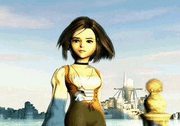
Garnet makes her vow.
Hilda makes amends with Cid and turns him back into human. Cid puts the finishing touches on his new airship, the Hilda Garde III. The black mages have realized Kuja was using them and return to the Black Mage Village. Garnet returns to Alexandria to visit her mother's resting place. When Zidane follows her she recovers from her silence, takes his dagger and cuts off her ponytail in a promise to continue to fight for her people and her adoptive mother.
Queen Hilda had been abducted by Kuja after she went missing as he had needed her airship, the first Hilda Garde. While captive, she learned of his plans and tells the party of Kuja's ambitions and that he hails from the planet of Terra, directing them towards Ipsen's Castle on the Forgotten Continent. Within the inverted structure the party finds four elemental mirrors: seals to the portal to Terra. After defeating the worm-like Taharka and rescuing Amarant from his own arrogance, Zidane forms four parties to secure each elemental shrine simultaneously. The defeat of the four Guardians and placing the mirrors to the shrines opens the path to Terra through the Shimmering Island.
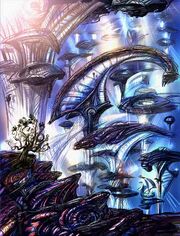
The dying world of Terra.
Terra is a mysterious dead planet that exists on the inside of Gaia. Millennia ago Terra had an advanced magical civilization and its inhabitants wished to become immortal and preserve their culture for all time. The life source of all planets in the cosmos is a crystal at the planet core that collects the memories of all living beings when the souls of the dead return to it at their life's end. Terrans' wish for immortality disrupted the natural order and when the Terran crystal weakened the Terrans assimilated other planets' crystals to preserve themselves.
Thousands of years ago Terra attempted to fuse with Gaia, but it ended with disaster and Terra shifted to the inside of the planet of Gaia. Terra's red moon moved to Gaia's orbit, and many Terran landmarks appeared on Gaia, such as Terra's magical tree of Iifa, and Oeilvert. Terrans tasked the android Garland, the old man who annihilated Alexandria and whom Kuja wishes to vanquish to become the overlord of Terra and Gaia both, with restoring Terra to its former glory before entering a deep rest. Garland crafted the Genomes to be used as vessels for the Terran souls when the time would be right for Terra to assimilate Gaia whose crystal has been deprived of its natural soul cycle by the Iifa Tree for thousands of years. Kuja was one of Garland's creations whom he sent to Gaia to incite war to amplify the rate the souls would attempt to return to the crystal, but Kuja's will was strong and he rebelled against his creator, knowing that if Garland's plans were to succeed he would no longer need Kuja and make him into a regular Genome.
In Terra the party meets the Genome girl Mikoto who leads the party to the Genome village of Bran Bal. Garnet glimpses the Invincible stationed outside the village and reclaims the memories of the time the airship destroyed Madain Sari and passes out. While the others care for her, Mikoto tells Zidane he is a Genome from Terra made by Garland to one day succeed Kuja, as after Kuja was created Garland had seen the errors in his design of having created him as an adult, rather than as a child capable of emotional growth. She leads Zidane to Garland who confirms everything and, horrified by what he has learned, Zidane attempts to fight him. Garland reluctantly decides to discard Zidane and make him a regular Genome and seals him within the Pandemonium, a palace where the ancient Terran souls rest. Garland fails to remove Zidane's soul and Zidane's friends free him and they confront Garland together.
Kuja has followed the party into Terra on his Silver Dragon and stolen the Invincible. He showcases his new mastery of Trance, achieved by draining the souls held within the airship and using the soul of a hateful person—Queen Brahne—as catalyst. Kuja dispatches the party with an Ultima spell and announces he will rule both Terra and Gaia. Garland warns him that his power is meaningless, but Kuja kicks his old master off Pandemonium's precipice to his death.
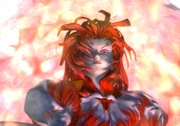
Kuja attacks Terra.
Garland remains as an omniscient voice and from beyond the grave tells Kuja his new-found goal is for naught; a limit on his lifespan was set when he was created, and his demise is fast approaching. Kuja's euphoria turns into rage and in his vanity he deduces that if he is going to die, he will take the world with him. Kuja obliterates Terra with wave after wave of Ultima spells, and the party and resident Genomes escape aboard the Invincible back through the Shimmering Island to Gaia. Mist has returned to the world, now enveloping the entire planet, flowing once more from the Iifa Tree.
While the Genomes move in with the black mages in their village, the party finds the foreboding entrance to Memoria hovering above the Iifa Tree, where Gaia's memories and Kuja await. The armies of Alexandria and Lindblum stave off the horde of Silver Dragons blocking Memoria's entryway and Invincible breaks through, carrying the party into Memoria that leads them back in time. Memoria is a place made manifest from the memories stored within Gaia's crystal, and the party witnesses the significant moments of their lives intertwined with the earliest stirrings of Gaia. Garland's lingering voice guides them through the dimension before leaving them at the entrance to the Crystal World, a realm where time does not exist, only memories of every life originating from the first Crystal where all planets are born from.
Saving reality / epilogue
After traveling through Memoria to the beginning of all time to the Crystal that is the lifesource of the universe, they find Kuja, intent on destroying it. Zidane and his friends face Kuja in battle, and in a last effort Kuja devastates the party with Ultima. The party awakes on the Hill of Despair, finding themselves in the presence of Necron, a deity-like being roused by Kuja's nihilism that arises to deny all existence by returning the world to the Zero World, a world without a Crystal, as he sees the suffering of living beings arising from their fear of death. The party defeats Necron in a final battle, who marvels at the party's will to persist even knowing they cannot escape death, and heeding their desire, departs.
Kuja uses the last of his strength to teleport the heroes onto the banks of the Iifa Tree. The others return to Alexandria on Cid's Hilda Garde III while Zidane searches for Kuja. He locates Kuja deep within the dying Iifa Tree, and as the latter accounts for his sins the collapsing tree's roots converge on them both.
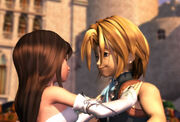
Garnet embraces Zidane.
Some time later Tantalus returns to Alexandria to perform I Want to Be Your Canary for Queen Garnet. Vivi has died, having come to the end of his lifespan, but as a legacy copies of him have been made, now known as "Vivi's sons." Though Vivi was unable to say goodbye to Zidane, he reminiscences on his time with the party in a soliloquy, thanking Zidane for helping him come to terms with his existence.
Everyone gathers up in Alexandria to see the play, Freya having found her lost love, Sir Fratley, and the two are repairing their relationship despite Fratley's amnesia. Amarant arrives with Lani, Quina works as a chef in the Alexandria Castle, and Eiko has been adopted by Cid and Hilda. Beatrix and Steiner, now a couple, act as Garnet's bodyguards and accompany her on the balcony where she watches the play. During the play a shrouded form masquerading as Marcus casts off his cloak to reveal a returning Zidane. Alexandria celebrates, old friends cheer from the stands, and the queen runs through the crowd and leaps into Zidane's arms.
Music
Final Fantasy IX is the last Final Fantasy game with music composed exclusively by Nobuo Uematsu. It was his most prolific score, as the original soundtrack has 110 tracks, and an additional soundtrack was released with 42 more. Years after its release, Uematsu has stated that both the score and the game itself are his favorite of all his projects.
Much of the music revolves around the themes of the J-pop ballad, "Melodies of Life", composed by Uematsu and performed by Emiko Shiratori. The song is sung in Japanese for the game's Japanese release, and in English for the game's North American and European releases.
Themes
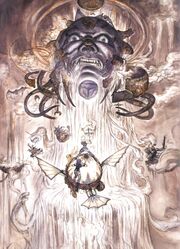
Yoshitaka Amano artwork of the party facing Necron.
The main theme of Final Fantasy IX is the meaning of life and death, mainly represented through the characters of Vivi and Kuja, although the other characters follow this arc as well. Vivi struggles to understand his purpose in life after learning he is an artificial being made in a factory for the purpose of war, and has to confront the reality of possessing a fixed lifespan. Kuja knows of his purpose since birth, but comes to rebel against his life as a tool for Garland. Despite being similar to the black mages he helps Queen Brahne produce, he does not feel empathy toward them, instead viewing them as inferior dolls; Kuja denies his origins and thus hides his identity as a Genome.
While Vivi comes to learn the purpose of life is to simply live it, as the experiences he accumulates throughout his journeys become memories that will return to the planet's crystal at his death thus contributing to the circle of life, Kuja is driven mad upon learning of his mortality and impending death. Rejecting the point of life entirely if one is doomed to die, Kuja tries to destroy the origin of all life, the crystal. His will to end all life summons Necron, a being who wants to take the world to the Zero World where nothing can exist, to release Kuja and all other beings of the world from the suffering of existence. The word "Necron" means "death", and thus gives the final battle a symbolic meaning. In the end, life triumphs over death when Zidane and his friends prove to Necron they want to live despite the knowledge they will die one day.
Life and death and the circle of life play a key role in many aspects of Final Fantasy IX, with the Iifa Tree being the symbolic tree of life—a prominent symbol across many cultures—and Terra being a dying world populated by dormant souls and soulless vessels, Genomes, whose lives remain incomplete if they are not assigned a soul like Kuja and Zidane did. Terra's struggle to continue existing despite its time being up by exploiting other planets goes against the circle of life, and in this way Kuja's fear of death and non-existence is the same as the Terrans'.
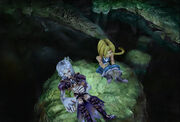
Kuja realizes "what it means to live" in the ending.
In the end Kuja accepts his mortality, but as the continuation of memory is a strong theme in Final Fantasy IX, his memory lives on, and in a final soliloquy Mikoto comments how Kuja's example gives hope to all remaining Genomes of how they can decide to be something more than tools and carve their own path in life. Vivi is implied of having died in a final message that plays during the ending, and ends his farewell by saying his memories are now part of the sky, an allusion to the circle of life.
Another major theme in Final Fantasy IX is to pay homage to the earlier installments of the Final Fantasy series, especially from the Nintendo era; Final Fantasy IX was meant to capture the "essence" of Final Fantasy, and the theme of crystals that had been present since the beginning of the series is brought back, the crystal now representing the life force of the universe. The game world was designed with traditional Final Fantasy world in mind, and the game makes numerous allusions to previous games.
Release
Template:See Also
PlayStation
PlayStation Network
Microsoft Windows (via Steam) and mobile
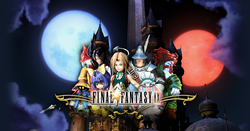
The promotional artwork for the 2016 re-release version.
On December 31, 2015 Square Enix announced on the Final Fantasy Portal App that Final Fantasy IX is coming to PC, iOS, and Android. A new microsite for the game was published stating that the game will require iOS 7.0 or Android 4.1 or later.
A teaser trailer was released on Square Enix's YouTube channel, showing the game with improved graphics, anti-aliasing filtering, new menu, new battle user interfaces, new message dialogue windows, new sprites for Tetra Master cards, high-definition movies, and improved character models. Achievements, auto-save, and speed-boost option are implemented. The player can now skip cutscenes, disable pre-battle fly-bys, and play in high speed mode (doubles all movement speeds, both in and out of battle). The "boosters" available are always full ATB/Trance/HP/MP, 9999 damage, no random encounters, Master abilities (equipping an item automatically unlocks its abilities permanently), and characters' levels and Magic Stones and the party's gil can be maxed out. The game has the original music.
Kouichiro Sakamoto directed the mobile version to commemorate the game's 15th anniversary.[2] He wanted to include features to shorten the playtime, and thus random encounters can be turned off. When Final Fantasy VII and Final Fantasy VIII were rereleased for the PC they had high-speed mode and boost features that were received well, so there were no objections to adding these features to Final Fantasy IX as well.[2]
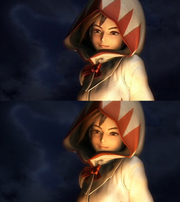
The original version at the top; the up-converted remake at the bottom.
The movies have been up-converted and the character models have been refined with textures in higher resolution. The backgrounds for most of the maps have been replaced by hi-res versions of the 2D data used in the original PlayStation version, but because the screen resolution on recent smartphones is so high, it can be hard to tell the backgrounds have been replaced. The developers didn't want the player to change their memories of the original game; the PlayStation images seem blocky now, but at the time players were impressed by them, and the developers didn't want the players' memories of the original game to look better than the port.[2]
The team at Silicon Studio in Thailand developed the Final Fantasy IX port for Square Enix, and put forth ideas for the touch screen interface used for the mobile version. The team vacillated whether to make it one tap to confirm or two taps to move and confirm, but ultimately ended up with the two-tap method, which results in fewer mistakes. If it was a new game, the developers could limit which data to show, but the game being a port, they couldn't just delete data that was shown in the original. It was also a challenge to make enough space for buttons that would be playable on a small screen, and to ensure the player's fingers wouldn't obscure relevant parts of the screen when playing.[2]
The port has two patterns of moving a character, but with the virtual controller the corners of the map would be obstructed by the player's fingers. Implementing a feature that lets the player tap where they want to go and automatically move simplifies controls and lessens the time the player's fingers cover up the screen. Because the battle screen covers the user interface when entering battle, there is a function that turns off all user interface displays while touching anything other than the commands.[2]
System requirements
| Minimum | Recommended | |
|---|---|---|
| OS | Windows Vista/7/8/8.1/10 | Windows 7/8/8.1/10 |
| Processor | Intel Core 2 Duo 2GHz | Intel Core i5 2520 2.5GHz or higher |
| Memory | 2 GB RAM | 4 GB RAM |
| Graphics | NVIDIA GeForce 8600GTS or ATI Radeon HD4650 | |
| DirectX | Version 11 | Version 11 |
| Storage | 7 GB | 20 GB |
| Sound Card | DirectSound® compatible sound card(DirectX®9.0c or later) | DirectSound® compatible sound card(DirectX®9.0c or later) |
Steam Trading Cards
Eight Steam trading cards will be released along with the game. Template:Gallery
Fan patches
Steam user Albeoris released his fan patch called "Memoria" for the PC version. It is a game engine modification patch features new functions such as increasing battle pace even further, an option to remove ATB system and play the game in turned-base mode, adding Beatrix and all the other guest characters to the party as a full-time playable characters, and save/load anywhere.
Reception
According to Metacritic, Final Fantasy IX is the most critically acclaimed Final Fantasy game to date.[3][4] It is also the favorite Final Fantasy game of series creator Hironobu Sakaguchi.[5] At the PlayStation Awards 2001 held on 11 June 2001, Final Fantasy IX was awarded the "Double Platinum Prize". It also swept the PlayStation User Awards at the same event, beating Dragon Quest VII to walk away with the awards "Best Graphics", "Best Scenario", "Best Characters", and "Best Sound". The results of these User Awards were obtained by polling PlayStation users nationwide.[6][7]
Production credits
| Executive Producers | Tomoyuki Takechi, Hisashi Suzuki |
|---|---|
| Conceived and Produced by | Hironobu Sakaguchi |
| Director | Hiroyuki Itou |
| Main Program | Hiroshi Kawai |
| Producer | Shinji Hashimito |
| Art Director | Hideo Minaba |
| Image Illustration | Yoshitaka Amano |
| Original Score and Music | Nobuo Uematsu |
| Event Design | Kazuhiko Aoki |
| Real Time Graphics | Akira Fujii |
| Battle Design | Yasushi Kurosawa |
| Battle Program | Takayuki Niwa |
| World Map Program | Tatsuya Yoshinari |
| World Map Graphics | Masahide Tanaka |
| Field Design | Mozomu Yamagishi, Takeshi Endo |
| Field Data | Hidetoshi Kezuka |
| Field Graphics | Shinichiro Okaniwa, Jun Sakurai, Kazuyuki Ikumori |
| Character Design | Shukou Murase, Toshiyuki Itahana, Shin Nagasawa |
| Character Modeling | Hiroshi Arai, Tomohiro Kayano |
| Character Animation | Jun Uriu, Tatsuya Kando |
| Computer Graphics Movie | Hiroshi Kuwabara |
| Sound Effects | Terukai Sugawara, Eiji Nakamura |
| Sound Program | Minoru Akao |
| 3D Character Programmer | Thomas Shih-Ta Peng |
| Production Manager | Akira Kashiwagi |
| Project Manager | Kenji Takemoto |
| Publicity Producer | Michio Okamiya |
| SQUARE VISUAL WORKS CO., LTD. | |
| Supervisor | Satoshi Tsukamoto |
| Director | Kiroshi Kuwabara |
| Manager | Norimichi Kurosawa |
| SQUARE SOUNDS CO., LTD. | |
| Music | Nobuo Uematsu |
| Sound Programmer | Minori Akao |
| Production Manager | Kensuke Matsushita |
| Conductor | Koji Haijima |
| SQUARTZ LTD. | |
| Executive Director | Hiromi Masuda |
| SQUARESOFT INC. | |
| Localization Specialists/Staff | Ryosuki Taketomi, Maki Yamane, Brody Phillips, Richard Amtower, Matthew B Rhoades |
| Localization Assistant | Rika Maruya |
| Localization Manager | Yutaka Sana |
| QA Staff, Senior Manager | Jonathon Williams |
| Senior Lead Analyst | David Carillo |
| Lead Analyst | Jaime Bencia |
| Assistant Lead Analysts | Jeff Love, Chris Manprin |
| QA Translators | Dana Kwon, Kenji Nakamura, Rintaro Yoshida |
| Analysts | Aaron J. Adams, John Carroll, Bryan Chen, Kelly Chun, Mat Clift, Michelle Elbert, Mike Erickson, Aron Gutierrez, Eric Lee, Jonathon Mankin, Greg Melancon, Jennifer Mukai, Michelle Ng, Tam Nguyen, Nicholas Pisani, Terry Stone, Dan Vanderputt, Stephen Wong, Hugo Yeh |
| SQUARE ELECTRONIC ARTS L.L.C. | |
| Senior Customer Service Manager | Rick Thompson |
| Customer Service Manager | Fernando Bustamante |
| Assistant Customer Service Manager | Alaine DeLeon |
| Senior Customer Support Representatives | Mark Abarca, Ryan Riley, Anthony Montana, Arec Nevers |
| Marketing Communications Manager | Kyoka Yamashita |
| Assistant Marketing Communications Manager | Francine DeMore |
| Product Coordinator | Ken Berry |
| Sales Coordinator | Sean Montgomery |
| Creative Services Manager | Keiko Kato |
| Creative Services Associate | Patrick Cervantes |
| Product Associates | Andy Hsu, Troy Boren |
| Product Administrative Assistant | Mari Nishikawa |
| Assistant Product Manager | Irene Sam |
| Product Manager | Andrew Shiozaki |
| Marketing Manager | Kenji Mimura |
| Vice Chairman | Yoshiro Maruyama |
| Senior Vice President | Kenzo Nogimura |
| President | Jun Iwasaki |
| Packaging/Manual Design | Beeline Group, Inc. |
| Special Thanks to | Beeline Group, BradyGames, Kenwood Group, Saatchi & Saatchi Los Angelas, Virtual Interactive, Kristopher Byrne, Charles Callistro, Jesse Cheek, Michael Christoffers, Scott Coventon, Roberta D'aprea, Justin Dornan, Jared Ellot, Reiko Fukuen, Ryan Gibson, Jason Haderlie, Natsu Ishigami, Takuya Ito, Drew Jennings, Terry Jung, Sonoko Kanayama, John Kim, Yoko Kondo, Yoshinobu Matsuo, Shigeto Matsushima, Hideaki Morishita, Haruko Nagata, Camilla Ortiz, Mayuu Salazar, Susan Stayer, Junko Takasawa, Mohammed Wright, Junichi Yanagihara, Hideo Yotsuya |
Packaging artwork
Template:Gallery
Allusions
Final Fantasy IX was intended, in many ways, to be a salute to the series' history, and as such, is filled with allusions to previous games. One of the most apparent is the similarity of the character Vivi to the black mage from the original Final Fantasy.
Despite the overall high quality of the translation, care was not taken to ensure all of the various names and references matched to those used in the previous English-language releases. Thus, many of the references with which the game abounds are missed by the non-Japanese audience. Examples are listed in the main article.
Trivia
- A Final Fantasy IX remake for PlayStation 2 had been considered by Square in early 2001, only one year after the original release. For some reason, the project was either scrapped or never started development at all. Similar projects for Final Fantasy VII and Vagrant Story were also considered at one point, but met the same fate.
- In May 2009, the video game website IGN interviewed Yoshinori Kitase and Takeshi Arakawa. During their discussion, Arakawa mentioned he desired to make a sequel to Final Fantasy IX more than any other game. [8]
- Final Fantasy IX has the most diverse cast of characters in the series, as it has only three human beings (Steiner, Amarant and Beatrix) and all the other playable characters are part of different races.
- Final Fantasy IX can have up to two players controlling the party during combat, even though the feature is not mentioned in the instruction manual.
- Final Fantasy IX has the most number of allusions in Dissidia Final Fantasy. The biggest one is Mognet. It is also said in Dissidia that the peak of life of the moogles happened in Gaia.
- The developers have stated they changed the ending seven times.[9]
- To promote the release of Final Fantasy IX, Square joined forces with Coca-Cola to produce a Final Fantasy IX themed Coca-Cola television commercial.
See also
- Final Fantasy IX Concept Art
- Final Fantasy IX Merchandise
- Final Fantasy IX Timeline
- Final Fantasy IX Translations
- Final Fantasy IX Wallpapers
- Final Fantasy IX Walkthroughs
External links
- Steam Store profile
- Outdated official North American site
- Official English site for the re-release
- Archive of European PlayOnline guide
- Wikipedia's entry on Final Fantasy IX
- Final Fantasy IX Screenshots
References
- ↑ http://www.jp.square-enix.com/ff9/en/
- ↑ 2.0 2.1 2.2 2.3 2.4 The challenges of porting Final Fantasy IX to Android and iOS (Accessed: UnknownError: See this for how to archive.) at Venturebeat
- ↑ http://www.metacritic.com/search/all/Final+Fantasy/results?sort=score
- ↑ http://www.metacritic.com/game/playstation/final-fantasy-ix
- ↑ http://uk.psx.ign.com/articles/077/077571p1.html
- ↑ http://game.watch.impress.co.jp/docs/20010611/psa.htm
- ↑ http://www.pcworld.idg.com.au/article/66126/final_fantasy_ix_big_winner_playstation_awards_2001/
- ↑ http://ps3.ign.com/articles/980/980580p1.html
- ↑ http://psx.ign.com/articles/085/085276p1.html
Template:FFIX Template:25thcompl Template:Series

